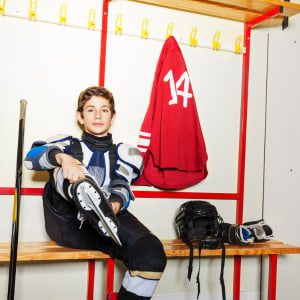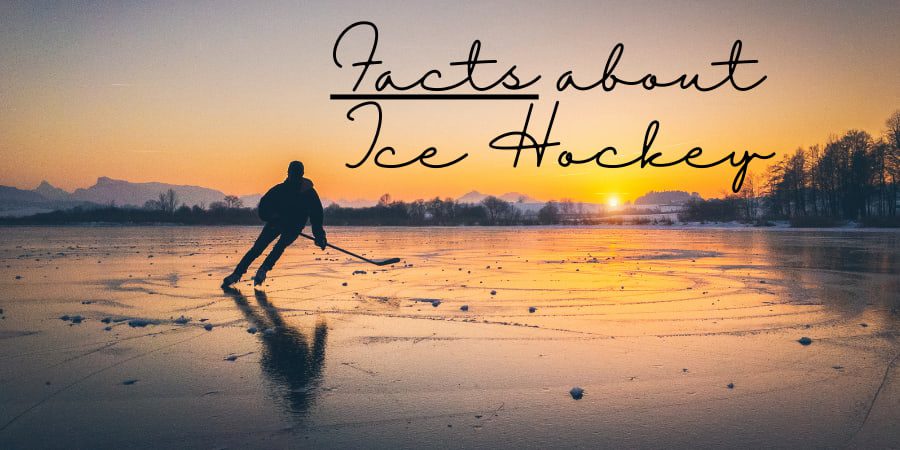What do Ice Hockey Players wear – The Best Parent’s Guide for Kids
If you are asking yourself..,”What do Ice Hockey players wear?” You are not alone! We are diving into the wild world of Ice Hockey gear…and yes, there is much gear. And, there are also uniforms that they wear over the gear. But, we will make it as simple and easy as possible as we detail the following equipment and clothing items.
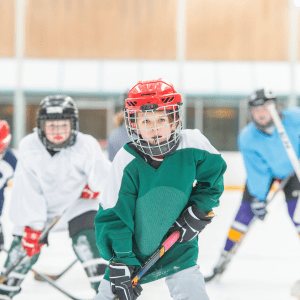
Hockey is a physical sport, Get ready to discover what you should buy to keep these mighty athletes safe playing a and ‘drippy’ (code from my teenager for looking cool) before they hit the rink! There will be other articles that will dive deeper into the specific types of equipment, and reviews. For purposes here, we are concentrating on youth equipment needs, as opposed to adult players where requirements are more relaxed.
This article will detail what they need to wear to get on the ice, and you can hop over to the Cafe for a coffee right before the first whistle!
Let’s gear up your little heroes with the right equipment, watch them conquer the ice, and witness the magic as they unleash their full potential. Get ready to cheer them on as they become the unstoppable force they were born to be! Go, go, superheroes!
What Ice Hockey players wear to Stay Safe and Look Sharp
Let’s break this protective gear down from head to toe…
Base Layers
These are top and bottom “Under Armour-like” fabrics. The fabric is usually a cold weather type of material, that wicks moisture away from the body. They try, but the kids still get soaked. They are moving, and they are kids, they usually don’t care. They will dry quickly, though. Base layers have become more of a layer of protection with some rib protection and utility to attach other pieces of hockey uniform items and serve a dual purpose, as you will see with hockey socks and sewn-in pockets for jock protection. Bottom base layers can be loose or tight compression, and long pants or shorts lengths depending on your liking.
Neck Guards
Don’t get me started on why mouthguards are regulated, but the neck protector is not as of 2023. Nevertheless, neck guards can protect against skate blades in the rare occurrence a player’s neck comes in contact somehow with a blade. As I write this, my son plays in the Midget age level now and I have to fight the ugly fight with him over the neck guard (eye roll). Get your kid off to a good start. If you have a young player, get them into the habit of wearing the neck guards now.
It might take some star players to bring it into vogue. But, eventually, I can see these also becoming mandatory.
The neck guards can be worn individually or as part of the base layer.
The Helmet (slang: ‘Bucket’)
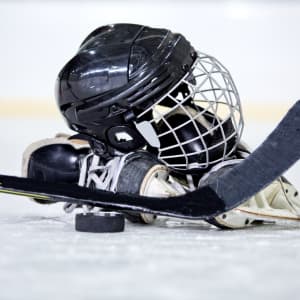
Say hello to the ultimate and most important piece of equipment, they will wear.
We’ll break down why helmets (also known as the Bucket) are crucial and how they keep those noggins safe from wild pucks and accidental collisions. Disclaimer parents…there is not one helmet that is able to protect against all concussions or serious injuries. Hockey helmets create a barrier between collision, pucks, and hits and are like a fortress for your kid’s face, shielding them from potential sticks and pucks. Chin straps properly placed (no ‘cage hang’ to look cool) are also a requirement of USA hockey.
Per USA Hockey Officiating Rulebook regarding helmets in an attempt to reduce head injuries:
“The Officials must make a visual check of all required protective equipment while the players are on the ice during warm-ups. Rule References 304(c and d) and 304(c Note).
The Referee should follow these steps to determine the legality of a required HECC-approved (Hockey Equipment Certification Council) helmet or facemask:
STEP 1: All approved helmets and facemasks should have a valid HECC-approved certification sticker with a date that is still current attached unless it has been removed by the player. The first burden of proof the helmet/facemask is eligible for use is the valid and unexpired certification sticker.
STEP 2: If the sticker(s) are not present, the official should have a basic knowledge of the required characteristics. These include ear protection for helmets and small enough openings in the facemask to prevent the butt-end of a stick from entering. In addition, the helmet chin strap and facemask chin cup and straps must also be present.
STEP 3: If still in question, the equipment models can be compared to the lists of certified equipment that is present on the HECC website (www.hecc.net).”
usahockeyrulebook.com/page/show/1084455-protective-equipment(opens in a new tab)usahockeyrulebook.com/page/show/1084455-protective-equipment
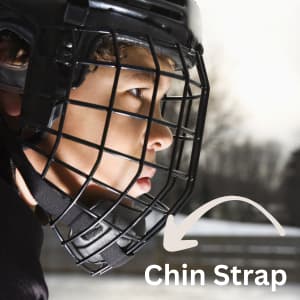
What helmet is the best to buy for Ice Hockey?
You will hear the arguments of expense and the type of play your young player may engage in.
I have heard “Well, they are little or they are not checking yet”…..so some parents may play the more frugal route when just starting. I never really cheaped out on the helmets, but I also did not get the most expensive. It was not because of price, but what I found after I dug through a lot of research (cause that is kind of jam), I educated myself on helmet safety even when he was a Mite or Squirt.
Here is my rationale…They are NOT that advanced, so their own skating or an opposing team’s skating and control on the ice may be less than perfect, of course. So, if my kid goes down, I do want the best protection. What I found was the best protection did not always mean the highest price helmet. And I would have paid the highest price to protect his brain because I was a Hockey Mom until I did my research.
I recall when my son moved from Football to Ice Hockey, we were also right on the cusp of when American Football players were educating the public on the long-term dangers of repeated concussions. I figured this issue would follow us from the field to the ice rink. And a good thing, it did…Thank God.
Virginia Tech Institute has one of the most comprehensive Hockey Helmet guides, last updated in 2023. You may see helmets here a few years old, but they last updated it this year, 2023 so new ones have been added. There are some oldies, but goodies. If nothing else, it is a great framework in terms of helmet rating scores, and how price is not always relative.
Helmet Fitting: Not too tight (headaches), and not too loose (falls or slides on the head, leaving bad visibility). I would recommend your local Hockey retailer to try on fit and size. If you choose to buy online, utilize the measurement keys for each product if you cannot get to the store. Some of the smaller youth helmets are able to expand with your kiddo’s head, as they grow. Yeah, I used this during his Mites and Squirts era for sure.
The Visor, Facemask or Cage (slang: ‘birdcage’)

Ever wondered why some players look like they’re rocking a face cage (birdcage) while others have a clear visor? We’ll explain the difference and the purpose behind these facial shields. It comes from a long history of missing teeth, facial fractures, and eye injuries. Thus, a full facemask is a mandate of USA Hockey for young hockey players.
The visor or cage attaches to the helmet. Both is like a fortress for your kid’s face, shielding them from potential sticks and pucks. It all depends on the preference of your little one. Mine has been from cage to full visor, back to cage, again….ugh.
A cage – just what it sounds like. and where the nickname ‘Birdcage’ comes from.
Clear as day – a clear visor (full visor covering the entire face per USA Hockey) can be clear replacing the usual full cages. The clear shields can at times “fog”, for which I would pick up spray for such.
Important takeaway – ensure the cage or visor you purchase fits the helmet. It is not all one size that snaps onto all. If buying at the retailer, I suggest buying it together. They are usually more than happy to also help you with attachments or pointers. I have found the guys at Pure Hockey polite, a fountain of knowledge, and more than generous with their time.
Sports glasses – If your kiddo wears glasses, once the speed of the game picks up you may consider specialized sports glasses or goggles that are helmet-friendly and fog resistant.
You will see NHL players and referees wearing half-visors. In professional hockey leagues and over the age of 18, NHL players will wear clear half visors.
Mouth guards:
Let’s talk about those awkward-looking mouthguards that make players resemble sharks. Parent Warning…they will try to “lose” these mouthguards if they don’t fit properly or become uncomfortable…well, even if they fit well, these tend to disappear like some kind of youth hockey phenomenon. But, mouthguards are not only USA Hockey regulation, they protect those chiclets (teeth)!
I suggest a mouthguard that attaches to the helmet. There are many brands, colors, coverage, and even scents and tastes (bubblegum, fruit flavored). The kiddos’ mouthguards are usually sized by age. When your kiddos “misplace” the $25 mouthguard frequently…this is a good point to use an attachment strap to the facemask grill. Tip: make sure the mouthguard is in a position where they can easily slide the mouthguard in place when they hit the ice.
Mold to Perfection: Boil-and-bite mouthguards offer a more customized fit by softening in hot water and shaping them to your child’s unique dental structure. Leave some time before practice or a game, Mom prepared to do the molding (pan of hot water and tongs required) prior to the game or practice. Each mouthguard has its respective instructions for molding to your kiddo’s mouth and comfort.
Shoulder Pads:
What happens when these little hockey players wear shoulder pads? Get ready for a transformation into Ice Hockey Superheros! With their shoulders and chest well-protected your little warriors can fearlessly engage in checks, hits, and even the occasional tumble more confidently with hockey pads. Shoulder pads provide us Moms with peace of mind and for the kids to focus on the game and unleash their skills.
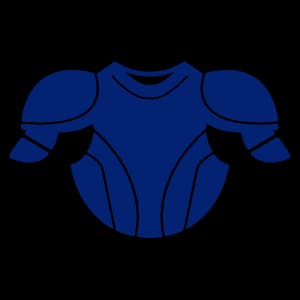
Let’s break it down – these shoulder pads have about three components of ultimate safety and reducing the risk of injury:
- Chest Protection: Even though the term may lend itself to a specific type of goalie equipment. There is also chest protection built into the “shoulder pads”. Think of the chest plate as their trusty shield, safeguarding their vital organs from unexpected collisions and stray pucks. It’s the first line of defense for our little ice heroes. Borrowed from baseball and other sports, the chest protectors today also could incorporate a Hart (Heart Guard) Gard built into the chest protector or worn alone under the shoulder pads. Or, as in with the goalie chest protector: Bauer Goalie Elite Chest Protector. I am amazed at how technologically advanced the materials that equipment manufacturers now use, and it gets better every day. Look for more at Pure Hockey or online at Amazon for our other regular players
- Shoulder Caps: These curved shoulder cups are like secret weapons, absorbing the force of impacts and ensuring your kids’ shoulders remain protected. They’re the key to maintaining their ice warrior status.
- Bicep Guards: Don’t forget the biceps! Bicep guards add an extra layer of protection, ensuring those upper arms remain unscathed from sticks, slashes, and accidental bumps.
And, then the Hockey Gods invented velcro! Don’t stress over it! Velcro tab to velcro tab makes it a breeze to adjust and secure their gear in place. Moving from tab to tab will eventually make them more independent when dressing themselves. Say goodbye to frustration and hello to hassle-free gear preparation.
Elbow Pads:
Elbow pads are essential gear that shields your child from falls, collisions, and the stray hockey puck. Remember to find the right size, adjust the velcro straps for a secure fit, and maintain the pads’ cleanliness. These are also measured by inches usually in terms of your kiddo’s height and weight to determine the “inches” in size.
Gloves:

Oh Ice Hockey gloves are fun! Gloves…the smelliest piece of equipment your kiddos will wear. Actually after puberty, just move all the equipment to another part of the house. Trust me!
But, no, gloves are super cute on those little fingers when little! They safeguard your child’s hands from slashes, stick checks, and accidental collisions on the ice, reducing the risk of injuries like cuts, bruises, and fractures.
Not only do gloves protect, but they also enhance your child’s grip on the stick, allowing for precise control and optimal performance during game day!
Comfort, Mobility, and Proper Sizing: Finding the right-sized gloves is crucial for comfort and safety. Too tight, and they’ll restrict movement. Too loose, and they won’t provide adequate protection, and they might fall right off! Follow the manufacturer’s size guide, and consider trying on different brands to find the perfect fit. Each equipment manufacturer will have different cuts (tighter vs. looser), as well.
Hockey Pants or Girdles:
Not what this sounds like. These are basically long padded shorts that protect the lower body, back, and kidney area from impacts, falls, and slashes. They’re padded in strategic areas such as the hips, thighs, and tailbone, providing a cushion of protection and minimizing injuries.
Jock Strap:
Please don’t let the boys talk you out of wearing one to protect sensitive areas. I have seen the puck him a poor boy on the ice when not wearing a jock strap. There are a variety of types – worn alone or most just wear the ones attached to compression shorts with a cup inside.
Shin Pads:
Shin pads are the ultimate defense for your child’s shins, shielding them from impacts and allowing fearless play on the ice. Find the right size, ensure proper coverage, and care for the shin pads to keep them game-ready. Shin guards usually encompass knee protection, as well.
Make sure the shin pads cover your child’s entire shin, from just below the knee to the top of their skates. Refer to the manufacturer’s sizing guide to find the ideal fit.
Balancing Mobility and Protection: While it’s important to have adequate coverage, the shin pads should not restrict your child’s movement or agility on the ice. Look for shin pads that provide ample protection without hindering their ability to skate, pivot, and maneuver effectively. You guessed it, their size comes in “inches” measurements usually correlated to age, height, and weight.
Hockey Skates:
Get ready to lace up and join us on an adventure to uncover the secrets of hockey skates!
First, is the hockey boot and sizing. This is worth a whole other article, just bear in mind here that when it comes to hockey skates, finding the right size is key. Get your child’s foot measured by a professional and refer to the manufacturer’s sizing chart to ensure a snug but comfortable fit. Remember, happy feet make for happy skaters.
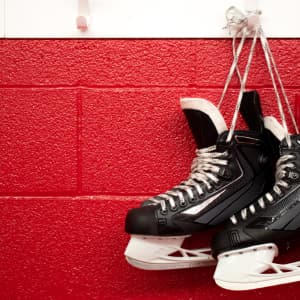
Room for Growth: Keep in mind that kids’ feet grow quickly. Leave a little room for growth when selecting skate sizes, but avoid getting skates that are too big. A proper fit ensures optimal performance and minimizes discomfort.
Skates may require “Baking” at the store. When it comes to baking skates, it’s best to leave it to the professionals. Head to a reputable skate shop or a skate technician who has experience with the baking process. They’ll have the right equipment and expertise to ensure it’s done correctly.
By customizing the skates to their unique foot shape, you’re providing enhanced comfort, and performance, and addressing specific fit issues. Remember to seek professional assistance, follow manufacturer guidelines, and allow for a proper cool-down period before hitting the ice.
Hockey skate blades are like the superheroes of the ice. They’re specially designed with a sharp edge, allowing your young player to glide effortlessly and make those lightning-fast turns and pivots. With sharp blades, ankle support, and the perfect fit, your little player will be ready to conquer the ice. Just remember to maintain the blades and protect them with blade guards off the ice.
Come prepared to practice with long socks, usually the tighter the better.
Player’s Stick (Slang: ‘Twig’):
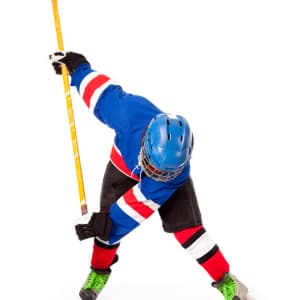
Ice hockey sticks have evolved from a variety of materials such as wood, and aluminum to new composite materials. My son loves these sticks for their different sizes, blade curve, and flex. More on this later. If you are a new hockey player, pick the correct hand dominance for your player and what they feel comfortable with. They will grow into different blades and flex preferences.
An ice hockey stick is your young player’s ultimate tool for stickhandling. With finesse and creativity, they can maneuver the puck through tight spaces, deke past opponents, and create scoring opportunities. It’s like watching a maestro perform their magic on the ice!
Hint: Defensive players may prefer longer-length sticks, but again this is so individual.
Hockey Bag:
A Home for Equipment: Hockey bags are like magical portals that keep all of your child’s hockey gear in one convenient place. From skates and pads to sticks and jerseys, these bags are the ultimate storage solution to keep everything organized and ready to go.
With designated compartments and pockets, hockey bags allow your young player to easily locate and retrieve their gear when it’s time to hit the ice. No more frantic searches for a missing elbow pad or mismatched socks. Well, so we may hope…haha.
For the younger guys, some come on wheels. I got my son’s first hockey bag on wheels in the Philadelphia Flyers colors off Facebook Marketplace. It was a steal and he loved it!
As they get older, it is customary for them to change to an over-the-shoulder bag. Some may get teased if they still have wheels around the age of 12ish. And, they may also request their particular school or team hockey bag for team spirit.
Ice Hockey Uniforms:
This is where it gets fun!
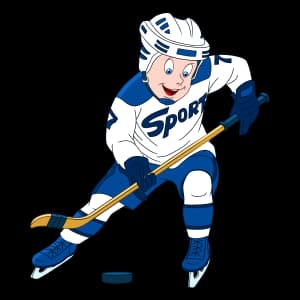
Hockey Jersey (also known as a Hockey Sweater):
Hockey jerseys are a symbol of team identity and pride. They prominently display the team’s colors, logo, and sometimes the player’s digit number, allowing fans to instantly recognize and support their favorite teams. They are made from breathable and moisture-wicking materials to keep players cool and comfortable during intense gameplay. The jerseys are also designed to be durable, with reinforced stitching and materials that can withstand the physical demands of the game.
Hockey Shells:
These shells go over the hockey (padded) pants. There is usually a team logo on the bottom of the short.
Hockey Socks:
These in your team’s colors cover the shin guards. If they have velcro tabs, they can be held up on the base layer of pants or shorts. Some are smooth polyester/cotton socks. Others mimic a weave of knitted vintage socks. Most hockey players will secure their hockey socks to keep them in place with clear tape.
Goalie Equipment:

God bless ya, Momma. Goalie parenting is not for the faint of heart.
Goalie equipment is a whole other universe of protective hockey gear. Due to the extra padding and protection required, goalie equipment can be more expensive. I will be doing another article soon on cutting some costs for all hockey players, but in particular, those parents who are at the end of the rink cheering on their favorite hockey goalie!
Goalie Facemasks:
First things first, let’s talk masks! Goalies wear specially designed masks that shield their beautiful faces from hurtling pucks and flying sticks.
Goalie Helmet:
Goalie helmets have a tough outer shell made of sturdy materials like fiberglass or carbon fiber composite. This molded shell adds strength and durability, ready to withstand the rigors of the game. This is also where they really express themselves…! There is protective padding from inside the helmet, you’ll find layers of cushioning foam that provide a comfortable and secure fit. This padding not only adds extra protection but also absorbs impact energy, minimizing the risk of head injuries.

Goalies really express themselves via their helmet decor or artist creativity! Talented artists, often specializing in helmet artwork, bring goalie helmet designs to life. These skilled artists work closely with goalies to understand their vision and create a design that reflects their personalities and preferences.
Some artists meticulously paint or airbrush the designs onto the helmet’s surface, paying attention to every detail. From intricate patterns to vibrant team logos, the goal is to create a stunning visual representation of the goalie’s style.
Goalie Chest Protector
Goalies need some serious armor to protect their chest and vital organs. The chest protector is like a superhero’s chest plate, absorbing the force of shots and collisions with the utmost strength.
Goalie Glove:
Goalies have a supersized glove that can snag pucks right out of the air. It’s like having a magic-catching hand, making jaw-dropping saves, and leaving everyone in awe. Usually worn on the non-dominant hand. Watch out, puck!
Goalie Pants:
Goalie pants are like the goalie’s secret weapon against hard shots and awkward falls. They’re extra padded to protect their hips, thighs, and knees. Trust me, they’re not your ordinary pants!
Goalie Sticks:
Goalie hockey sticks are the ultimate tools of the trade for our brave netminders. With their longer length, unique fatter blade design, customized curves, and reinforced shafts, goalie sticks unleash the goalie’s athleticism. They provide the reach, control, and durability necessary to make those unbelievable saves and be a force to reckon with, especially those low pucks at ankle height.
Goalie Blocker:
Think waffle board held in the hand of dominance, that also holds the hockey stick. The goalie’s blocker is like their own personal shield. It’s designed to block and deflect shots with precision and sharp reflexes.
Goalie Leg Pads:
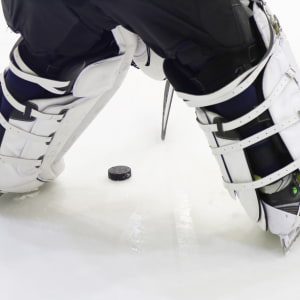
Have you seen those gigantic leg pads? They’re like goalie shields, protecting the goalie’s legs from high-speed pucks and providing maximum coverage. Go, goalie, go!
Goalie Neck Guard:
Safety is a goalie’s top priority, which is why they wear a neck guard. It protects their neck and throat from stray sticks and slashes. Safety first, always!

